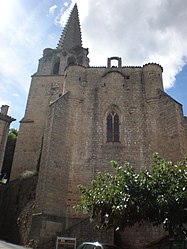Chassiers
Chassiers is a commune with 1003 inhabitants (as of January 1, 2011 ) in Ardèche, in the Rhône -Alpes. Residents will (it) called Chassiérois.
Geography
The municipality covers the southern part of the Cevennes and borders, inter alia, to the municipalities Largentière and Vinezac. It is part of the Regional Natural Park of Monts d' Ardèche. In the south, close to the foothills of the Tanargue. The next largest city is Aubenas seven miles north-east from the hotel. The village is situated along the river Ligne. In addition, the country flows through the municipal area.
History
Chassiers was first mentioned in 549 in a document on the conservation of mines in the region around Largentière.
The well-known local historian Albin Mazon also assumes that a monastery by the Bishop of Viviers, Mélianus II, was founded in honor of Saint Benoît in this time. However, the corresponding source is gone for a long time and been recorded after Mauzon in the "Charter Vetus " from the 10th century. The text has been written in illegible handwriting of the early Middle Ages, but could not be deciphered by most historians. So even by Père Colombi, the first was in the 17th century, who had dealt with the documents of the Charter. Against the thesis of Mauzon also speaks of the fact that no remains or traces of a former monastery can be found on the current municipal area.
On February 26, 1584 " Brotherhood of blue penitents " ( confrérie of pénitents bleus ) was founded on the initiative of the then feudal lord Louis de la Vernade. The congregation grew so approach to the regional center of power of the Catholic Church and had to subsequently 1562 and during the wars of religion against attacks by the feuding Protestant minority, the Huguenots, defend. During a battle in 1568, the castle of the community, the Château de la Mothe- Chalendar was looted. It belonged in the 14th century the rich family Chalendar until it was sold to the Rivière family in the 16th century.
Management
The community belongs to the Association of Municipalities Val de Ligne. 2008, the non-party Jean -Marie Knockaert was elected mayor.
Culture and sights
Chassiers is a picturesque town with a predominantly made of limestone houses dating mainly from the Middle Ages.
The village is home to two castles. The Château de la Mothe- Chalendar from the 15th century with Senkbrücke and round towers. After it was looted in the religious wars of the Huguenots and set on fire, it was in 1568 and rebuilt in 1585. For better protection against enemies in addition a moat was built, which goes around the plant.
The Castle of Jacques de Vernade from the 15th and 16th centuries can be seen from afar because of its large round tower. As a stronghold of Catholicism, numerous meetings of the diocese of Viviers were held at this location. Today it houses the mayor's office.
Furthermore, let there are two chapels and a church. The chapel of Saint -Benoît Büßerordens of Les Penitents Bleus are all in the Romanesque style of the late 17th century. This religious community has settled from 1584 until the end of the 19th century there for practicing their faith. Probably the sacred building was erected on the site of a former monastery, which had led to the first mention of Chassiers. The chapel has two apses and two naves, to separate the believer from the clergy. In 1562 she was also attacked and damaged by the Huguenots.
Located on the village square church of Saint- Hilaire from the 15th century is mainly in Gothic style, but conspicuous by their strong attachment. An accessible from outside the crypt below the church building houses the local library.
The Chapel of Notre- Dame de Bonne Rencontre, which is located a little above the village, is currently being restored. The panoramic view that can be enjoyed from the higher -lying hamlet of Les Combes, attracts many hikers in the place.










